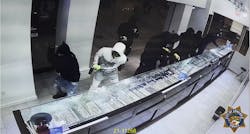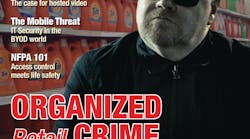How to combat flash mob and smash & grab ORC
Note: This appeared as a blog on the Security Advisors Consulting Group, LLC website on December 2 and being reprinted with permission of the author.
As the holiday season nears in the United States, an ugly threat faced by retailers resurfaces and may be more prevalent than ever. Over the last several weeks, retailers in several metro areas have experienced large, coordinated groups forcing their way into the store, filling their arms or bags with high-value merchandise, and running out the door to escape in carefully staged waiting vehicles. Some of these “flash mob” or “smash and grab” robberies have included:
- Five people entered a Nordstrom’s department store in a Los Angeles suburb, spraying a security guard with a chemical irritant designed for hikers to use to deter attack by bears, and made off with over $25,000 worth of designer handbags.
- Fourteen individuals forced their way into a Louis Vuitton store in the Chicago suburb of Oakbrook, stealing over $120,000 worth of merchandise in under a minute, assaulting an employee who attempted to stop them on the way out, and fleeing in three vehicles at least one of which had been reported as stolen in October.
- Between 80 and 90 individuals invaded a Nordstrom’s store in Walnut Creek, a suburb of San Francisco, armed with pepper spray, crowbars, knives, and firearms. Once in the store, they assaulted employees with pepper spray, crowbars, and in one case a knife before fleeing the area with over $100,000 worth of merchandise. Three of the suspects were apprehended by police as they left and some of the stolen merchandise was recovered along with a firearm being taken off one of the suspects.
- At a Sunglass Hut store in the Del Monte Shopping Center in Monterey, Calif., four individuals entered the store in the early afternoon, assaulted two employees, and stole approximately $30,000 worth of merchandise before fleeing.
- In Chicago, in the early morning hours, thieves used a brick to smash windows to Canada Goose store on the city’s Magnificent Mile stealing a number of coats while others used tools to smash windows and pry open doors to North Face, Footlocker, and Boost Mobile stores in other neighborhoods of the city.
- Nine individuals carrying sledgehammers entered Iceberg Diamonds in the Sun Valley Mall in Concord, Calif. They spent less than a minute smashing display cases and grabbing fists full of jewelry while threatening employees who tried to intervene and then running from the store with their loot to vehicles waiting in the parking lot.
- Thieves targeted two Best Buy stores in Minneapolis suburbs with 10-15 thieves entering a store in Maplewood, east of the city, while 20-30 people entered a store in Burnsville, south of the city, at around 8:00 pm on a Sunday stealing electronics including televisions, computers, and tablets before fleeing.
- A Sam’s Jewelers store in a mall in San Jose, Calif., was targeted by a mob of 30-40 people who rushed into the store wielding sledgehammers to smash display cases and grab merchandise before fleeing the store and mall.
- A shoe store in Santa Clara, Calif., was subjected to two smash and grab burglaries within a week when a mob of fifteen to thirty people forced their way into the store on Wednesday night stealing shoes and clothing, thieves then returned on Sunday night breaking out the store's windows to gain entry and steal additional items including pairs of shoes valued at over $1,000 per each.
- A Neiman Marcus department store located on Chicago’s Magnificent Mile was targeted by three cars which disgorged fifteen thieves who rushed into the store grabbed clothing and other merchandise and fled. It should be noted that this type of crime is not a new phenomenon with similar robberies being recorded at this location in 2014, 2019, and 2020.
Explaining the Dynamics of the Mob
Other stores reportedly targeted over the past week have included pharmacies, cannabis dispensaries, hardware stores, high-end clothing retailers, jewelers, and electronics stores. In Oakland, Calif., Kevin Nishita, a retired police sergeant from the Coloma California Police Department was providing security for a news crew covering another flash mob robbery, when he and his protectees were accosted by a group of armed robbers who shot and killed Nishita. While each of these incidents has slightly different dynamics they do share several similarities in their execution.
Crime is committed en masse to limit the likelihood of police or security who may be on the scene from being able to apprehend all of the suspects, limiting the perceived risk to each participant and ensuring that at least some of them will escape with the loot.
To ensure that the crime is completed prior to an effective response being generated by local law enforcement the attack itself lasts an extremely short period of time, in most cases less than a minute.
The retailer targeted has a significant volume of high dollar value merchandise, particularly jewelry, designer clothing or accessories, electronics, or drugs. All of which are items that are easily resaleable through a number of different gray market channels, such as auction websites, social media platforms, or swap meets. One notable deviation from this was the recent robbery of a Home Depot store in Lakewood, Calif., a suburb of Los Angeles, where a mob of 10 people forced their way into the store and stole a number of sledgehammers, crowbars, and other tools that could be used to commit other robberies.
In many cases, the perpetrators have shown willingness to use violence against any employees or bystanders who attempt to thwart their plans, often coming prepared and armed with chemical irritants or weapons. The 2020 Organized Retail Crime Survey from the National Retail Federation[1] found that nearly sixty percent of retailers surveyed reported that criminals were more or much more likely to “exhibit aggression and violence” than in 2019, a year which saw a nearly 70% positive response to the same question.
Almost every one of the targeted retailers also has a location that allows for an easy escape route for the thieves, typically in multiple vehicles left waiting in the parking lot.
The vast majority of victimized businesses are either in major metropolitan areas or in suburbs within twenty miles of a major metropolitan area.
There is some discussion over whether these incidents meet the typical definition of “organized retail crime” (ORC) and are coordinated and planned by a group of professional thieves who recruit individuals, often juveniles, to commit the actual robbery for a small fee or cut of the stolen merchandise, or if these are more loosely organized by the participants themselves over social media.
Regardless of who is driving this increase, it is almost certain that the significant attention given to these incidents on the news will have the unintended consequence of creating copycat thieves who see the success others have had with this type of robbery, see the methods used, and are convinced to try it for themselves. In 2020, the aforementioned survey found that retailers experienced a 9.8% increase in losses attributed to organized retail crime ($719,548 per billion dollars of sales revenue) over the same numbers from 2019.
If you listen to the news or social media reports many of the talking heads argue that the increase in these crimes is driven by overall inequities in society or approaches to criminal justice and policing in many cities across the United States. While this may be true, resolving those greater societal issues will take time and is beyond the immediate scope of the business owner who simply wants to protect their investment in their business and their employees. So, with this increase and indications that this is not a passing trend every business should be re-evaluating their risk of experiencing a similar incident. Factors that can play into that are similar to those listed above and include:
Does your business stock high dollar value, easily resaleable merchandise that can be easily carried away during a robbery?
Are you located within easy driving distance of a major metro area, particularly one that has experienced significant numbers of these robberies already?
Is your business located somewhere where thieves would be allowed an easy escape route to waiting vehicles?
How Can Businesses Protect Themselves?
While these factors may indicate an increased risk for experiencing this type of incident, not having one or more of these present does not mean that your business’ risk is zero and the potential must still be considered although with lower levels of risk the measures deployed may be less intensive. As with any crime prevention measures, the steps taken to protect a business against these crimes should be aimed at reducing the attractiveness as a target. While not an effective law enforcement strategy, a business’s security and loss prevention strategy can rely in large part on making themselves a less attractive target than other similar businesses, hoping that criminals will then target their competitors rather than them.
With that in mind, what measures can a business implement to make themselves a less attractive target or at least lessen the impact if they are targeted by this type of crime? These solutions should be geared toward reducing the attractiveness of the location by limiting the visibility of high-value goods or access to them.
Perhaps most effective is developing methods to identify a potential flash mob before they enter the store combined with physical security measures that allow staff to effectively lock down the store quickly. This also relies on target hardening of the store’s outer envelope with either rolldown gates which can be quickly deployed or by use of laminate or other burglar-resistant glass in doors and storefront windows that will resist breakage. This may prove particularly useful in shopping mall settings where there is significant distance between parking and target areas. While it may be difficult to identify smaller groups of criminals the gathering of a large mob of 20-100 people wearing face-covering and carrying burglary tools staging in the shopping center’s parking lot may be able to be identified prior to entry. If the shopping center’s security team has effective methods in place to identify this threat en route and an effective process to communicate that threat to tenants it may be possible for the tenants to secure their premises prior to entry.
Traditional loss prevention measures such as RFID tags that alarm when exiting a store or dye packs on clothing items that require a special tool to remove, which are typically removed at checkout, may not be effective in preventing theft during a flash mob or smash and grab robbery as the nature of the theft and the level of organization involved typically indicates that the group do not care about detection and are likely equipped to remove any security tags in place once they have left the store. While significantly more expensive, one potential option is for the business to deploy GPS trackers that can be located by law enforcement after the fact on some higher value merchandise. Although, with its limitations due to the cost of the devices, the need to be able to effectively conceal them on the merchandise so they are not discovered soon after the theft, and the capacity of local law enforcement to follow up on the investigation in a timely manner make this a solution that likely only makes sense in some of the highest risk environments.
A retailer may also make their location less attractive by limiting the amount of inventory available in public areas, keeping storerooms where inventory is always kept secure, and securing display models of the merchandise with theft prevention hardware such as cables and locking stands. Unfortunately, this works best for electronics and cell phone retailers, and may not be of much use for clothing stores where multiple sizes of items need to be accessible for legitimate customers to try on.
Jewelry and other retailers of small high-dollar value items can also limit their losses from, and hopefully deter, this type of robbery by using display cases that are rated to resist forceful entry attempts. While these may not fully prevent entry they will at least slow the criminals who are likely to get access to fewer items in the short time that they have allotted to be in your store.
To prevent smash and grab thefts from outside the building it makes sense for retailers in higher risk areas to ensure that all exterior glass on their storefront is made of laminated glass which will resist attempts at entry by blunt force rather than typically tempered glass that will shatter and allow entry. For locations with vehicle access directly next to their entrance, bollards should be installed to prevent vehicle ramming attacks that can be used to breach front doors after hours.
Another security system that has been deployed with some success or systems designed to obscure the ability of the thieves to quickly identify the merchandise they want to steal and disorient them. These systems may accomplish this through rapid deployment of a massive amount of “fog” or “smoke” or through blinding strobe lights that can be activated by staff in case of a robbery and can potentially make more disorienting to the thieves by integration with loud sirens. The cost of these systems is dependent on the area covered and they may be less effective in non-self-contained spaces such as suites within a shopping mall where smoke will spill out into the larger mall area.
Video surveillance systems have become ubiquitous in retail establishments, especially those dealing with high-value merchandise. Unfortunately, they have shown to provide little to no deterrent value in preventing these types of crimes and the use of their footage in solving these crimes has been limited by criminals' use of face coverings and use of stolen cars as get-away vehicles. The retailer may want to evaluate the current placement of cameras in their surveillance system and optimize them so as to be most likely to capture an image that can be used to identify the perpetrators after the fact. Some potentially useful locations are face-height cameras at the entrance to the store and cameras with sufficient resolution for facial identification covering parking areas.
If possible the business should utilize elements of crime prevention through environmental design (CPTED) to reduce its attractiveness to those planning this type of robbery, these can include extensive use of glass to allow for visual surveillance of the parking lot by those inside and of inside activity by passersby, and location of items attractive to thieves away from exits making a quick entry and exit more difficult.
Staffing the business with a security employee is often touted as one of the more effective methods of theft prevention, but this comes with significant cost and in the cases that we have seen it does not appear to have provided a significant deterrent as businesses that did have uniformed security have been targeted along with those that do not. If the business does decide that hire security, whether your own employee, a contracted security company or off-duty police, their responsibilities in a robbery must be determined beforehand. If they are expected to attempt to intervene they must be equipped with tools that will allow them to safely do so and the business must be prepared for results of that intervention as it may quickly escalate and an armed guard may be required to take someone’s life when that may not have otherwise been necessary if their intervention did not escalate the confrontation.
Perhaps the most effective long-term solution, retailers should proactively work with local ORC prevention coalitions and local law enforcement to identify and prosecute not only those committing the robbery itself but any organizers and those involved in the pipelines for distribution and resale of the stolen goods.
Most importantly, no amount of merchandise is worth an employee’s life, so employees should be trained to either not intervene or to intervene only in non-physical ways that limit the likelihood of them being assaulted by the perpetrators.
None of these solutions are one-size-fits-all and each business must actively evaluate the risks posed to it from this type of crime and how to best address it in its own unique environment. Hopefully by doing so, business can reduce their attractiveness to this type of crime and by doing so keep their merchandise, and more importantly their employees and customers safe.
About the author: Drew Neckar CPP, CHPA has nearly thirty years of experience in the safety and security field. He has served as the senior-most security executive (CSO) for organizations in the healthcare, financial services, education, and hospitality sectors and as a Regional Security Director for Mayo Clinic. He has presented on various security-related topics at regional and national conferences and has been published in multiple professional journals. Drew is board certified as a Certified Healthcare Protection Administrator (CHPA) by the International Association or Healthcare Safety and Security, a Certified CPTED Specialist by the American Crime Prevention Institute, a Certified Protection Professional (CPP) by ASIS International and serves on that organization’s Healthcare Security and School Security Councils. He owns and operates Security Advisors Consulting Group a full-service security consulting firm and serves as the Vice President of Operations for Security Management Services International Inc. He can be contacted at [email protected]





